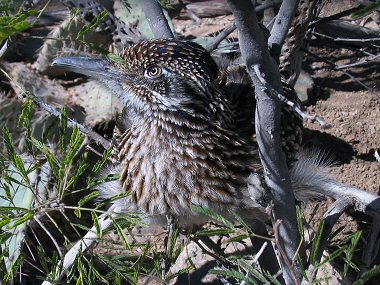| |
Greater Roadrunner
 |
 |
 |
|
|
| The Greater Roadrunner is the most famous
bird in the Sonoran Desert and not only due to the cartoon. It is easily
recognizable as a large, black-and-white, mottled ground bird with a
distinctive head crest. It has strong feet, a long, white-tipped tail
and an large bill. It ranges in length from 20 to 24 inches from the tip
of its tail to the end of its beak. It is a member of the Cuckoo Family,
characterized by feet with 2 forward toes and 2 behind. |
| |
 |
Natural
History |
 |
|
The Roadrunner can be mainly be found in
the southern portions of California, Arizona, New Mexico (where it is
the state bird) and Texas. It inhabits open, flat or rolling desert
terrain with scattered cover of dry brush or chaparral. Their diet
consists mainly of animals like insects, snails, lizards, scorpions,
spiders and also young birds or small mammals. Roadrunners are famous
for their ability to catch rattlesnakes. They pick the snakes up by their tails and kill them by
slamming the head to the ground. In winter Roadrunners eat more plant
material, because animal prey can be hard to find at that time of year.
rattlesnakes. They pick the snakes up by their tails and kill them by
slamming the head to the ground. In winter Roadrunners eat more plant
material, because animal prey can be hard to find at that time of year.
|
Roadrunners prefer walking or
running to flying and attain speeds of up to 17 mph on foot. |
Greater Roadrunners reach sexual maturity at the age
of 2-3 years. They build a shallow nest in a low tree, bush or cactus,
or rarely on the ground. The nest is often located in a place where it
will be in the shade during the hottest part of the day. The female lays
2-12 white eggs, which are incubated for 18-20 days. The eggs are laid
in a period of a few days and so not all young hatch at the same time.
The youngest and smallest ones generally do not survive; sometimes they
are even eaten by the parents. After 18 days they leave the nest,
staying with their parents for another 2 weeks before they set off on
their own. Greater Roadrunners may live up to 7 or 8 years. |
Back to Flora & Fauna |
|

